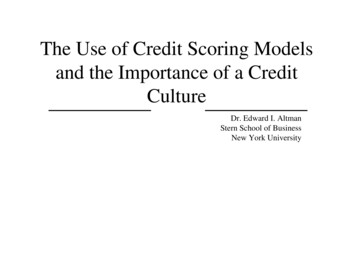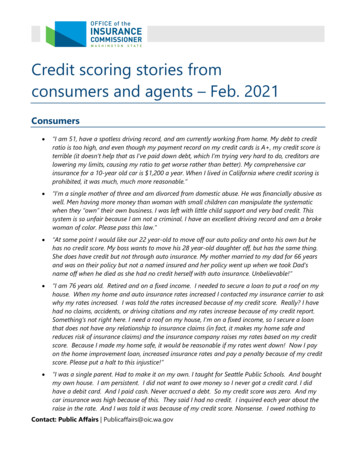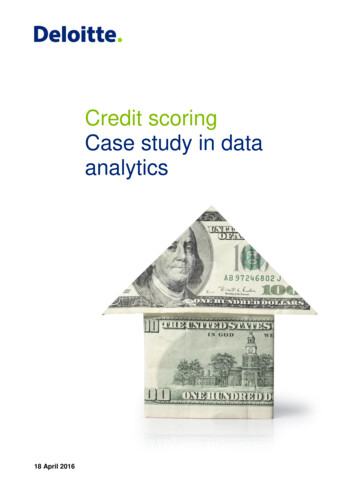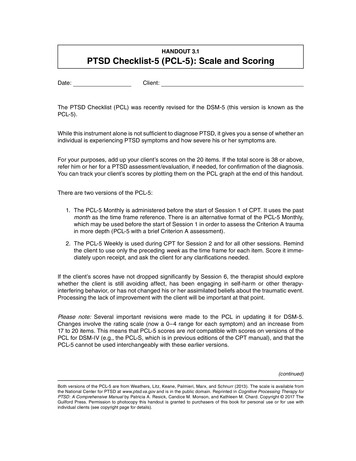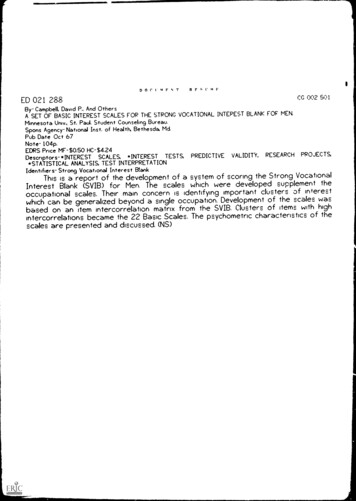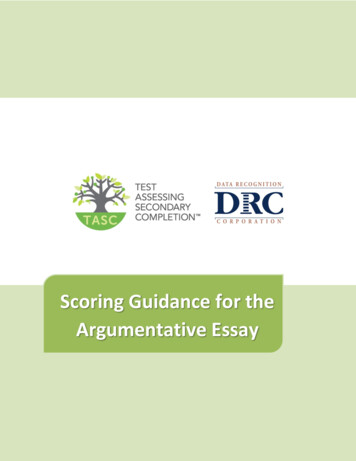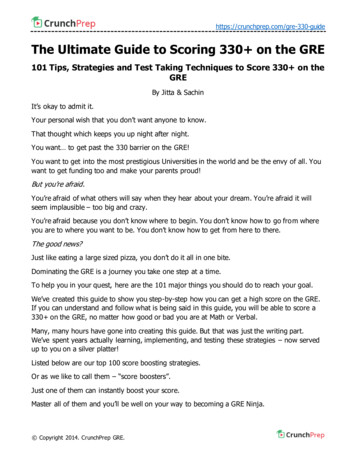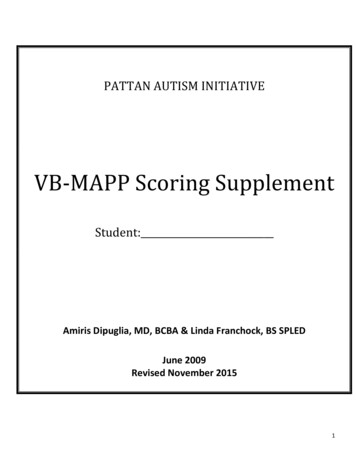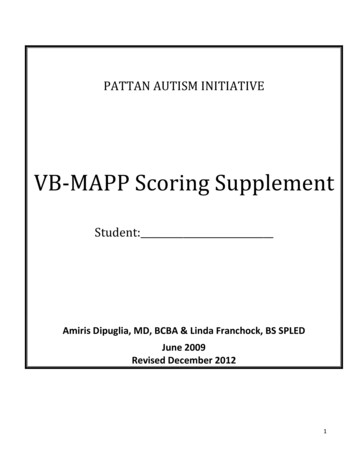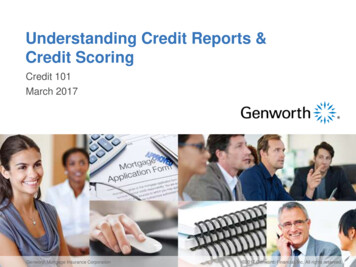
Transcription
Understanding Credit Reports &Credit ScoringCredit 101March 2017Genworth Mortgage Insurance Corporation 2017 Genworth Financial, Inc. All rights reserved.
Overview & Course ObjectivesCredit Reports & ScoringCredit Reports & Scoring are designed to help individuals understand their role andresponsibilities when viewing credit reports. It will prepare Mortgage LoanOriginators with the required knowledge in order to successfully analyze aborrowers credit report. You will obtain a clear understanding of the types of creditreports and how to access these reports. You will also have an understanding of allcredit reporting and nontraditional credit compliance guidelines Upon completion of this course, attendees will be able to effectively:–Understand Credit Report Types–Review and Analyze Credit Reports–Obtain a clear understanding of Credit Scoring Basics–Understand Agency Guidelines–Gain knowledge of the legal requirements of FICO ScoreCredit Reports & Credit Scoring2
The Credit ManualCredit Reports & Credit Scoring3
Session OverviewCredit 101 is designed to help individuals understand their role andresponsibilities when viewing credit reports. Upon completion of this course, attendees will be able to effectively: – Understand Credit Report Types– Review and Analyze Credit Reports– Obtain a clear understanding of Credit Scoring Basics– Gain knowledge of the legal requirements of FICO Score– Understand Agency Credit GuidelinesCredit Reports & Credit Scoring4
The Credit ReportA credit report is a record of the borrower’s credit activities. Thereport allows you to review the borrower’s current liabilities and theirpayment history There are two different types of credit reports typically used in themortgage industry – An in-file credit report is credit data received directly from a national creditrepository/bureau. The information is not manually verified. It is verified via aprocess at each bureau when receiving data – A tri-merge credit report is obtained from a credit reporting agency and containsdata collected from three national credit repositories/bureausCredit Reports & Credit Scoring5
Requesting The Credit ReportMake sure when you order any type of credit report you: – Get the complete legal name of the borrower– Use the correct spelling of both the first and last name– Identify any alias the borrower may have– Confirm whether the borrower uses any generation suffix (Jr., III )– Obtain a previous address if the borrower has been at the current address forless than 2 years Only businesses or individuals with a “permissible purpose” can access aconsumer’s credit report. Consumers must be fully aware that their creditwill be accessed and have granted permission to do so Any person who knowingly or willfully obtains a consumer report from a consumer reporting agency underfalse pretenses, or any officer or employee who knowingly or willfully provides information concerning anindividual from the agency’s files to a person not authorized to receive that information shall be fined orimprisoned not more than 2 years, or both. Follow your company’s policies and procedures on requesting a consumer’s permission and accessing their credit Credit Reports & Credit Scoring6
Credit BasicsCredit Reports & Credit Scoring7
Where is the Borrower’s Credit InformationLocated?Creditors voluntarily report the information to National Credit Repositories/Bureaus.A credit repository/bureau is a clearinghouse for credit history information. Creditgrantors provide the bureau with factual information on their credit customer’spayment history and credit usage. Each bureau assembles that information, alongwith public record information obtained from courthouses, into a file on eachconsumer. There are three major credit bureaus: Equifax : PO BOX 740256 ATLANTA, GA 30374 (800) 685-1111 www.equifax.com/fcra Experian : PO BOX 2002 ALLEN, TX 75013(888) 397-3742 www.experian.com/reportaccess TransUnion : PO BOX 1000 CHESTER, PA 19022 (800) 916-8800 www.transunion.com/myoptionsThese national bureaus maintain centralized databases containing the credit records of more than 200million Americans. Credit bureaus generate over a half-billion credit reports a year Credit Reports & Credit Scoring8
Where is the Borrower’s Credit InformationLocated?Some things to remember: Credit bureaus do not rate credit Credit bureaus do not approve or reject consumer applications for credit Credit bureaus only store and report the informationCredit Reports & Credit Scoring9
Who Prepares The Credit Report?Consumer reporting agencies prepare credit reports. These agencies: – Specialize in obtaining records on the credit history of almost everyone who hasobtained credit– Contact national bureaus for credit history as well as identity verifications andfraud alertsCredit Reports & Credit Scoring10
Primary Categories of Information There are five primary categories of information:– Identifying information Identifying info may include: Name, current & previous addresses, social securitynumber, telephone number, date of birth and current and previous employers– Credit history History of paying bills with credit grantors such as: retail stores, banks, financecompanies and mortgage companies– Public records All available public record information and judgments, foreclosures, tax liens andbankruptcies– Inquiries Information about inquiries during the past 120 days. However, a consumer’s copy willlist all inquiries for the past 24 months– Alert Information Information showing active military duty alerts, fraud alert statements, and potentiallymis-matched informationCredit Reports & Credit Scoring11
What Details Does The Credit ReportInclude?For each Tradeline listed it should include: ’s nameDate the account was openedAmount of the highest credit or original loan amountRequired payment amount and unpaid balanceCurrent status of the accountWhen the account was last activeThe date the information was sent to the repositoryPartial account numberType of accountA tally of how many 30,60, and 90-day delinquencies are reportingHow many months the account has been reported to the repositoryAny past due amountPayment historyAny remarks or Special Comments to describe the loan situation (real estate loan, loanmodification, in dispute, FNMA loan, etc.)Credit Reports & Credit Scoring12
What the Credit Report Does Not IncludeYou should not see: – Checking or savings account information– Medical history– Purchases made with cash– Income payment amounts made to accounts– Previous balances held (unless it is a consumer version)– Race, gender, religion, or national originCredit Reports & Credit Scoring13
Free Personal Credit ReportThe Fair Credit Reporting Act (FCRA) and the Fair and Accurate CreditTransactions (FACT) Act, provide that every consumer is entitled toone free* Personal Credit Report from each of the 3 national creditrepositories/bureaus annually – Request Online– Request by Phone– Request by Mail:www.annualcreditreport.com(877) 322-8228 Annual Credit Report Request Service P.O. Box 105281 Atlanta, GA 30348-5281*It is important to note that a credit report is free, but a score is not. People often confuse andinterchange "report" and "score" Credit Reports & Credit Scoring14
The Credit ReportCredit Reports & Credit Scoring15
Credit Report Legend ExamplesEqual Credit Opportunity Act (ECOA) Credit Reports & Credit Scoring16
Credit Report Legend ExamplesWHOSE Codes WHOSE CodesB: Account returns fromrepositories under borrower'snameC: Account returns fromrepositories under co-applicant'snameJ: Account returns from therepositories under both applicantand co-applicant names Credit Reports & Credit Scoring17
Credit Report Legend ExamplesAccount Type Credit Reports & Credit Scoring18
Credit Report Legend ExamplesAccount Status Credit Reports & Credit Scoring19
Credit Report Legend ExamplesRating Code Status – The type of account on which the borrower owes can impact how the debt iscalculated for mortgage lending Credit Reports & Credit Scoring 20
Credit Report Tradeline ExamplesMortgage Tradeline Example A Mortgage Tradeline needs additional caution taken when reviewingThe payment on the report typically represents the payment based on repaying the note. It does notinclude escrows of taxes and insurances that the mortgage servicer may be collectingVerify the complete obligation through:Copies of the mortgage servicing monthly statementVerify what, if any, escrows are being collected. Based on recent changes, HomeOwners/Hazard policies may no longer be collected.If mortgage loan is non escrowed or non-impounded, verification of current taxes and hazardinsurance amounts are requiredIf property is a coop, condo or PUD, association dues must also be documented verifiedIf an Automated Underwriting System (AUS) is being used, verify that any reported late payments havebeen disclosed to the AUSCredit Reports & Credit Scoring21
Credit Report Tradeline ExamplesReporting Source Each tradeline identifies which bureaus are reporting the information. The tradelinereferenced above contains the reference XP/TU/EF. This indicates that all three of thebureaus, XP (Experian), TU (Trans Union) and EF (Equifax), had this information. TheXP/TU/EF indicates that account data was obtained from all three, but does not meanthat they all have the same data. Unmerging the data or reviewing a tradelinecomparison report will show you how each bureau is reporting the accountSome Investors may require a minimum number of tradelines active and reported onbehalf of your borrowerExample-Your underwriting manual states that each borrower must have a usable credit scoreconsisting of a minimum of 3 open tradelinesCredit Reports & Credit Scoring22
DU/DO Release Notes DU Version 10.0Credit Reports & Credit Scoring23
DU/DO Release Notes DU Version 10.0Appendix ACredit Reports & Credit Scoring24
Credit Report Tradeline Examples-TrendedCredit DataDU Version 10.0 will use trended credit data in the risk assessment. – Trended data will include historical monthly data including: balance, scheduledpayment, and actual payment amount that the borrower made– Initially, DU will only use the trended credit data on revolving credit cardaccounts for the most recent 24 months’ payment history– This information enhances the DU risk assessmentCredit Reports & Credit Scoring25
Trended Credit DataNo additional review of this information will be required initially.Initially the trended credit data will only be reported by Equifax & Trans Union.Credit Reports & Credit Scoring26
Trended Credit DataCredit Reports & Credit Scoring27
Trended Credit DataNo Name Yet“Revolver”“Transactor”Full Payment Partial Payment Minimum PaymentTrended Data shows: – What kind of spender the applicant is– How their behavior has changed over time (are they trending up or down?).– How often they open & close accounts– What they spend/pay every monthCredit Reports & Credit Scoring28
Credit Report Tradeline ExamplesCollection Account Remember to include all collection amounts that are required to be paid in the totalassets requiredCheck products and program guidelines to verify if a collection must be paid offprior to or at closing - guidelines will vary from product to productIt is important to note that a collection and a chargeoff are the same payment status,but are different account types. Be sure to check your guidelines for specificrequirementsCredit Reports & Credit Scoring29
Credit Report Tradeline ExamplesPublic Records Delinquent credit—including taxes, judgments, tax liens, mechanic’s ormaterialmen’s liens, and liens that have the potential to affect an Investor’s lienposition or diminish the borrower’s equity—must be paid off at or prior to closing.Some exceptions exist based on the underwriting method (manual or AUS) andyour InvestorSee Investor n/pdfs/deliver/allregs combined.pdfCredit Reports & Credit Scoring30
Credit Report ExamplesInquires Please check your company guidelines on how to address recent credit inquires!Credit inquires may indicate that the borrower has recently applied for new and/oradditional creditIf the borrower has obtained new and/or additional credit, the amount of debt and therepayment amount typically must be considered in calculating the borrower’sindebtedness (DTI)Credit Reports & Credit Scoring31
Credit Report ExamplesCreditor List The Credit List may be useful if the borrower sees a discrepancy on their report andneeds contact information. If any information has been reported inaccurately andneeds to be revised, a Credit Supplement is typically requiredPlease note that medical collections reported to Equifax will not contain the name or contact informationfor the collection agency. A consumer would have to contact Equifax directly to obtain that informationCredit Reports & Credit Scoring32
How Long Will Items Remain on aConsumers Credit Profile?The chart below references how long credit items will remain on theconsumer’s record. The timeframes do not indicate how long the items willimpact (positively or negatively) a consumer’s Credit Score TypeLimitationBankruptcy Chapter 7 or 10 years from the date filed11 & Non-discharged ordismissed Chapter 13Bankruptcy Chapter 13(discharged)Suits & JudgmentsTax Liens - PAIDTax Liens - UNPAIDCharged to Profit & LossCriminal RecordLimitationsOther AdverseInformation7 years from the date filed7 years from date of entry orexpiration of appropriate statute oflimitations, whichever is longer7 years from date of payment*No limitation7 yearsNo Limitations on criminal conviction7 years*Based on IRS r-credit-report/Credit Reports & Credit Scoring33
Credit DisputesConsumer Disputes Fair Credit Reporting Act (FCRA) Changes to credit data must take place at the repository level in order for theinformation to affect the score. Consumers must write a letter of dispute regardingthe erroneous information to the appropriate repository referencing the tradeline,account number(s), and the specifics of the reported error. Each bureau/repositoryhas an online dispute method as well Under the Fair Credit Reporting Act, a credit repository has 5 days from receipt of awritten consumer dispute request to contact the appropriate credit grantor about therequest. And 30 days, of the original repository notification, to receive a reply back Within 5 days of completion of the investigation, the repository must send a writtenreport to the consumer with its findings (and a copy of the revised report if therewere any changes) Credit Reports & Credit Scoring34
Credit DisputesConsumer Disputes (FCRA) Outcomes: Consumer Disputes mayresult in three possible scenarios: – No response from the creditor at all the data is REMOVED– Confirmation from the creditor the data STANDS– Revision by the creditor the data is CHANGEDIn all cases, the consumer is NOTIFIED of the results For additional information please access the two websites referenced belowFederal Trade Commission (FTC) Guidance on Credit Disputes CFPB Guidance on Credit Disputes Credit Reports & Credit Scoring35
Credit ScoringCredit Reports & Credit Scoring36
Credit Scoring BasicsWhat is a Credit Score? – A Statistical Model– A Predictor of Future Performance Based on Prior Experience– A Model Based on Known Performance– A Scorecard Factoring in Many Characteristics– A Value Falling in a Range from approximately 300 to 850 in the mortgageindustry. Several others have expanded/different rangesCredit Reports & Credit Scoring37
Scoring ModelsThe Scoring Models that are used in the mortgage industry weredeveloped and are maintained by Fair Isaac Corp. – FICO The most common credit score in use was developed by Fair IsaacCorporation (FICO) Evaluates the borrower’s credit data Assigns a “score” which predicts borrower’s likelihood to repay creditobligationsCredit Reports & Credit Scoring38
Benefits of Credit & Mortgage ScoringScoring enables lenders to:– Achieve consistency & objectivity in underwriting– Identify high risk loans from a credit perspective– Bring efficiency, consistency and profitability to all aspects of the industryScores are indicators of risk and performance for the credit portion of thefile. Underwriters continue to use their knowledge and experience, as wellas agency guidelines to evaluate risk and make loan decisions Credit Reports & Credit Scoring39
What Is In A Credit ScoreAccording to MyFico.com a Credit Score is created based on datawithin 5 major categories: – Payment History– Amount Owed– New Credit– Length of Credit History– Types of Credit in UseCredit Reports & Credit Scoring40
How Scores Are Calculatedwww.myfico.comCredit Reports & Credit Scoring41
What Is Not In A Credit ScoreFICO Scores consider a wide range of information on your creditreport. However, they do not consider: – Your race, color, religion, national origin, sex and marital status (US law prohibitscredit scoring from considering these facts, as well as any receipt of publicassistance, or the exercise of any consumer right under the Consumer CreditProtection Act)– Your age (other types of scores may consider your age, but FICO Scores don't)– Your salary, occupation, title, employer, date employed or employment history(Lenders may consider this information) as well as other types of scores– Where you live– Any interest rate being charged on a particular credit card or other account– Any items reported as child/family support obligationsCredit Reports & Credit Scoring42
What Is Not In A Credit ScoreFICO Scores consider a wide range of information on your creditreport. However, they do not consider: continued – Certain types of inquiries (requests for your credit report)– Your scores do not count “consumer-initiated” inquiries – requests you havemade for your credit report, in order to check it– They do not count “promotional inquiries” – requests made by lenders in order tomake you a “pre-approved” credit offer – or “administrative inquiries” – requestsmade by lenders to review your account with them– Requests that are marked as coming from employers are not counted– Any information not found in your credit report– Any information that is not proven to be predictive of future credit performance– Whether or not you are participating in a credit counseling of any kindCredit Reports & Credit Scoring43
Generating A Credit ScoreWhat are the minimum requirements to generate a FICO Score? – At least 1 account that has been open for a minimum of 6 months– At least 1 undisputed account that has been reported to the credit bureau withinthe last six months– No indication that the consumer is deceasedCredit Reports & Credit Scoring44
Why Wasn’t It A Perfect ScoreThe Reason Codes will be included in the report when a credit score isordered. – Reason codes are listed in DESCENDING order of importance and aredisplayed with each score– Reason codes show which area of the consumer’s credit did not score as highlyas possible. In some cases – these reasons highlight issues not associated withtraditional “derogatory” information– These codes can be relayed back to the borrower to explain how they canchange/improve their credit profile (over time)– Score factors seem le
The Credit Report A credit report is a record of the borrower’s credit activities. The report allows you to review the borrower’s current liabilities and their payment history There are two different types of credit reports typically used in the mortgage industry –An in-file

